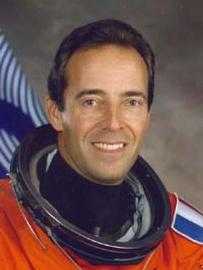Jean-François Clervoy
| Jean-François Clervoy | |
|---|---|
 | |
| CNES/ESA Astronaut | |
| Nationality | French |
| Status | Active |
| Born |
19 November 1958 Longeville-lès-Metz, France |
| Other occupation | Engineer, Flight test engineer |
| Rank | Ingénieur Général de 2e classe |
| Time in space | 28d 03h 05m |
| Selection | 1985 CNES Group 2, 1992 ESA Group |
| Missions | STS-66, STS-84, STS-103 |
| Mission insignia |
|
Jean-François André Clervoy (born 19 November 1958) is a French engineer and a CNES and ESA astronaut. He is a veteran of three NASA Space Shuttle missions.
Personal life
Clervoy was born 19 November 1958 in Longeville-lès-Metz, France. He therefore considers himself as Lorrain Mosellan, but also as Toulousain by adoption. He has a twin brother, Patrick, a military physician. He is married to the former Laurence Boulanger. They have two children. Clervoy enjoys racquet sports, skill games, canyoning, skiing, and flying activities such as boomerang, frisbee, kites.
Education
Received his baccalauréat from Collège Militaire de Saint Cyr l' Ecole in 1976; passed Math. Sup. and Math. Spé. M' at Prytanée Militaire, La Flèche in 1978. Graduated from Ecole Polytechnique, Paris, in 1981, he became a member of the Corps of Armament. He graduated from École nationale supérieure de l'aéronautique et de l'espace, Toulouse, in 1983; graduated as a Flight Test Engineer from École du personnel navigant d'essais et de réception, Istres, in 1987.
He graduated from high-school in Saint-Cyr Lycee, and then joined a class for preparation of "Grandes écoles" being admitted to the École polytechnique. Later he joined the SUPAERO engineering school and finally he was accepted at the EPNER (École du personnel navigant d'essais et de réception) a test pilot/engineer school based in Istres (south of France). There he trained as a test engineer.
He is a member of Association of Space Explorers and a distinguished member of the French Aeronautics and Astronautics Association.
Astronaut career
Clervoy was seconded from the Délégation Générale pour L' Armement (DGA) to CNES (French Space Agency) when he was selected in the second group of French astronauts in 1985 and started an intensive Russian language training.
From 1987 until 1992 he directed the Parabolic Flight Programme at the Flight Test Centre, Brétigny-sur-Orge and provided technical support to the European Manned Space Programmes within the ESA Hermes crew office.
From 1983 to 1987, Clervoy was also a lecturer in signal processing and general mechanics at the Ecole Nationale Supérieure de l' Aéronautique et de l' Espace, Toulouse. Jean-François holds a commission as Ingénieur en Chef de l' Armement in the DGA.
In 1991, he trained in Star City, Moscow, on the Soyuz and Mit systems. In 1992, he joined the astronaut corps of the European Space Agency (ESA) at the European Astronaut Centre (EAC) in Cologne.
Clervoy was detached to the NASA Johnson Space Center/Houston in August 1992 to gain Space Shuttle mission specialist qualifications. In between his space flights, Clervoy was assigned as flight software verification lead in the Shuttle Avionics Integration Laboratory (SAIL) and as robotics display design lead for Shuttle and Station. After his third space flight, he provided collateral duties in the NASA-JSC Astronaut Office on “International Space Station display integration lead” within the Space Station Operations Branch.
He flew twice aboard Space Shuttle Atlantis and once aboard Discovery for a total of 675 hours in space.
Clervoy holds military and civilian parachuting licenses, military and civilian scuba-diving licenses, and private pilot license.
Clervoy is a member of ESA's European Astronaut Corps, whose homebase is the European Astronaut Centre (EAC) located in Cologne, Germany. He is currently seconded to the ATV (Automated Transfer Vehicle) ESA project as Senior Advisor Astronaut in Les Mureaux (France). He is also president of Novespace, the European company which provides zero-g flights with an Airbus A300.
Spaceflight experience
STS-66 Atlantis (3–14 November 1994), the Atmospheric Laboratory for Applications and Science-3 (ATLAS-3) mission was part of an ongoing program to determine the Earth's energy balance and atmospheric change over an eleven-year solar cycle. Clervoy used the robotic arm to deploy the CRISTA-SPAS atmospheric research satellite 20 hours after lift-off. The mission was accomplished in 175 Earth orbits, traveling 4.5 million miles in 262 hours and 34 minutes.
STS-84 Atlantis (15–24 May 1997), was NASA’s sixth Shuttle mission to rendezvous and dock with the Russian Space Station Mir. As the Payload Commander, Clervoy’s primary tasks were the coordination of the execution of more than 20 experiments, the operation of the docking system and the double module SPACEHAB, and the transfer of 4 tons of equipment between Atlantis and Mir. He was also trained as a contingency spacewalker on this mission. STS-84 was accomplished in 144 Earth orbits, traveling 3.6 million miles in.221 hours and 20 minutes.
STS-103 Discovery (19–27 December 1999), was an 8-day mission during which the crew successfully installed new instruments and upgraded systems on the Hubble Space Telescope (HST). Clervoy was the flight engineer for ascent, entry and rendezvous. He used the robot arm to capture and deploy the telescope, and to maneuver the suited astronauts during 3 eight hour long spacewalks required to repair and upgrade the telescope. The STS-103 mission was accomplished in 120 Earth orbits, traveling 3.2 million miles in 191 hours and 11 minutes.
Awards and honors
- NASA Space Flight Medals (three)
- NASA Exceptional Service Medals (two)
- Officier de l' Ordre National de la Légion d' Honneur,
- Chevalier de l' Ordre National du Mérite
- Komarov and Koroliev Awards from the Fédération Aéronautique Internationale.
External links
| ||||||||||||||
|